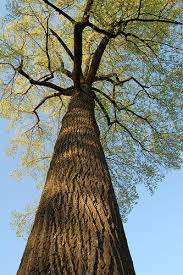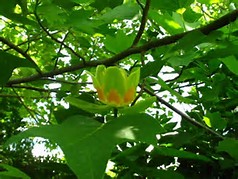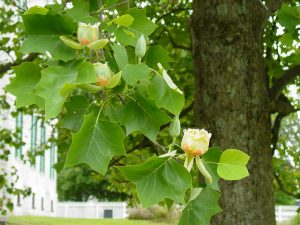
Tulip Poplar Tree
The Tulip Poplar tree, scientifically known as the (Liriodendron Tulipirefa) has very spectacular blooms that resemble tulip flowers. The tulip poplar tree is not under no circumstance related to the poplar tree or tulip flower. It belongs to the magnolia family. In the spring, the tulip poplar tree will blossom fully with yellow or green fragrant flowers which are two to three inches in diameter covering the whole plant. It attracts numerous pollinating insects and birds. The leaves of the tulip poplar tree are tulip shaped and can grow up to eight inches long. It is a deciduous plant which usually sheds its leaves during the winter, but before then you will witness a spectacular display of brilliant and beautiful golden foliage.
Tulip trees prefer full sun locations with fertile, moist soil that drains well. The plant starts out in a pyramid shape but matures to an arching dome except where limited sun is available. In low light situations, the branches can get skinny and weak. The plant has a fleshy root system that doesn’t extend far out from the plant, so well worked soil is essential for planting. The tree tolerates drought poorly, so make sure it has access to water or give it supplemental irrigation in summer and early fall. The soil pH should be moderate to acidic. Make sure the tree will have ample space in the area you choose since it will become very tall and branch out up to 40 feet.
Growing the tulip poplar tree is quite easy, all you have to do is take care of the tree from its early stages up to when it finally mature.
Caring for a tulip tree is relatively easy;
- Fertilize in early spring and watch for pests and disease. Stake young trees early on and train to one straight leader.
- Due to the rapid growth of this tree, pruning is essential. It poses a competitive challenge to other trees in the nearby area, and the brittle branches pose a possible hazard to passersby. Prune dead and weak growth in late winter to early spring and do a thorough thinning every few years.
- Don’t allow the plants to dry out, but don’t overwater either. It is a little bit drought resistant but then again excess water will soak it and make the soil holding and supporting it loose. It retains water for quite some time thus its drought resistant nature.
- Unfortunately, this tree is a victim to several canker diseases and poplar weevils. Combat the weevils with horticultural oil and the canker with an appropriate fungicide. These diseases and the pests weaken the tulip tree, and it will affect its growth.

Attributes
- The tulip poplar tree blooms in the spring producing tulip- shaped flowers with yellow petals and a little bit of orange at the base.
- Has an aromatic stem.
- Eventually grows in an oval shape.
- Produces colorful seeds held upright in the tree throughout the summer and autumn
- The tree is considered both a shade tree and an ornamental tree because it features a spreading canopy which blocks sunlight and adds visual beauty.